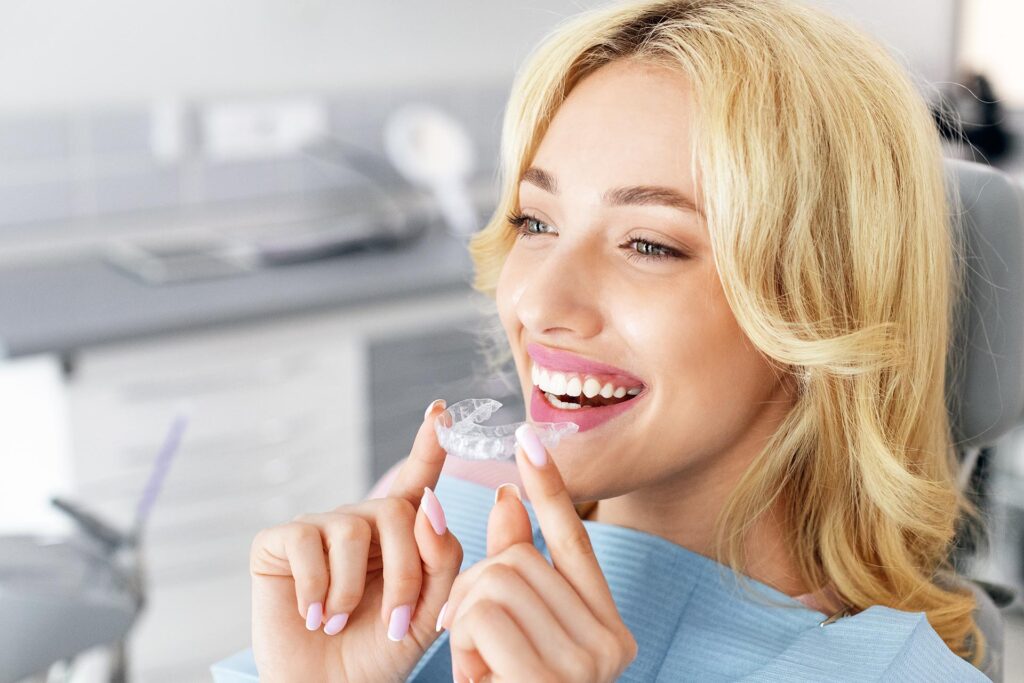
Invisalign (clear dental aligners) and braces are among the most preferred orthodontic treatment methods. With both treatment methods, an aesthetically beautiful smile and healthy oral and dental structure can be achieved.
Orthodontics is a specialty of dentistry that creates an oral structure with compatible teeth by treating teeth that are incompatible with each other, crooked, gapped, embedded in the gingival and crooked. The teeth are guided to the desired point by moving them at a millimeter level within the bone with movable, functional and fixed instruments for periods of months.
Less complex oral and dental structures can be treated with dental aligners, complex with braces and much more complex with lingual braces. Dental aligners are almost invisible, braces are visible, while lingual braces are invisible as the braces and brackets remain on the inner surface of the teeth.
Children should be examined at the age of 7, as teeth are mostly caused by disorders during the developmental age of individuals. While simple dental problems can be solved with invisalign first between the ages of 7-10 by monitoring development, braces treatment is planned at the earliest between the ages of 10-12.
Invisalign is a brand of clear dental aligners. It is suitable for patients without complex dental problems. Digital treatment planning is made after the examination by the dentist. First of all, decay and tartar cleaning is performed, if any. The simulation of the treatment process and outcome can be seen in advance. Since it is clear, it is almost unnoticeable in the mouth. Plaques suitable for the treatment to be applied to the patient and the oral structure are customized with three-dimensional scanning. Clear aligners consist of sets that are replaced in stages of 1-2 weeks.
Dental aligners have become more and more preferred in recent years, especially by young people, due to their inconspicuousness, ease of treatment and low frequency of control.
The treatment proceeds by gently moving each tooth individually by applying constant force. The gingival are reshaped around the moving tooth. When the aligners are first worn, there may be a slight lisp in speech during the adaptation process. For successful progress in treatment, they should be worn for 20-22 hours a day. When removed for a long time, the treatment process is prolonged as the teeth may shift towards the starting point.
Using the aligners requires discipline. Some patients get bored of constantly taking the aligners off and putting them on. Since they do not pay attention to their use, no progress can be seen in their treatment with this method. It would be more beneficial for these patients to use braces.
The ability of patients with veneers or crowns to use Invisalign is evaluated separately by specialist dentists. Invisalign treatment is not preferred in patients with two or more teeth bridged.
In braces treatment, metal, ceramic or glass brackets are glued to the front surface of the teeth and wires are passed over them. In some cases, elastic materials can also be used to help orientation to the desired point.
Table 1 shows the advantages and disadvantages of Invisalign and braces compared to each other.
| Invisalign (Clear aligners) | Braces | |
|---|---|---|
| Age | Children, youth and adults | Children, youth and adults |
| Hygiene | Removable, convenient for eating, oral and dental care | Oral care is more difficult because the brackets are attached to the teeth |
| Aesthetics | Not noticeable | Visible |
| Speech | Some patients may have a slight lisp | No impact |
| Session length | 15-20 minutes | 30 minutes |
| Session period | 2-3 months | 1-2 months |
| Patient compliance | Wear 20-22 hours a day for treatment success | More flexible compliance for treatment success |
| Tooth movement | Suitable for small rotates and advances | Suitable for complex tooth movements |
| Emergency examination | Not required | Need in cases of loosening |
| Prohibited foods | Gum cannot be chewed, removal of plaque is recommended with other foods and drinks | Avoid apples, pears, hard and sticky foods, popcorn, chips, alcoholic and carbonated drinks |
| Duration of treatment | 6-18 months | 1-2 years |
| Pain | Feeling of pressure on first use | Feeling of pressure on first use |
| After treatment | Retainer recommended | Retainer recommended |
| Material | Thermoplastic | Metal, ceramic or glass bracket, metal wire |
Table 1. Invisalign and braces comparison




